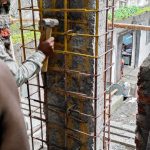Structural retrofitting, a process that enhances the structural performance of buildings, plays a crucial role in ensuring the safety, longevity, and functionality of various structures.

As an essential aspect of modern construction and civil engineering, retrofitting not only safeguards buildings against potential hazards but also contributes to sustainability and economic efficiency. This comprehensive article delves into the benefits of structural retrofitting, emphasizing its importance and advantages
1. Enhanced Safety and Resilience
Protection Against Natural Disasters
Structural retrofitting significantly improves a building’s ability to withstand natural disasters such as earthquakes, hurricanes, and floods. By reinforcing the structural elements, retrofitting helps in absorbing and dissipating the energy generated during these catastrophic events, thus minimizing the risk of structural failure and ensuring the safety of occupants.
Reduction of Seismic Vulnerability
In earthquake-prone areas, retrofitting is indispensable. It reduces the seismic vulnerability of structures by upgrading the building’s foundation, frame, and joints. Techniques such as base isolation, adding shear walls, and strengthening columns and beams are employed to enhance the building’s earthquake resistance.
2. Extended Lifespan of Structures
Prolonging Structural Integrity
Retrofitting addresses and rectifies the wear and tear that buildings undergo over time. By reinforcing weakened components and repairing damages, it extends the lifespan of structures, ensuring they remain functional and safe for longer periods.
Adaptation to Modern Standards
Older buildings often do not comply with current building codes and standards. Structural retrofitting upgrades these buildings to meet contemporary safety and performance standards, making them compliant with regulations and more resilient against future challenges.
3. Cost Efficiency and Economic Benefits
Cost-Effective Alternative to Reconstruction
Retrofitting is generally more cost-effective than demolishing and reconstructing a building. It allows for significant improvements in structural performance at a fraction of the cost of new construction, thereby providing an economically viable solution for property owners.
Reduction in Maintenance Costs
By enhancing the durability and resilience of a structure, retrofitting reduces the need for frequent and costly repairs. This long-term reduction in maintenance expenses translates to substantial savings for building owners.
4. Environmental and Sustainability Benefits
Resource Conservation
Retrofitting is an environmentally sustainable practice as it involves the preservation and improvement of existing structures rather than their replacement. This conservation of resources reduces the demand for new construction materials, thereby minimizing environmental impact.
Reduction of Carbon Footprint
By extending the life of buildings and reducing the need for new construction, retrofitting significantly lowers the carbon footprint associated with construction activities. The use of sustainable materials and energy-efficient technologies in retrofitting further contributes to environmental conservation.
5. Improved Aesthetics and Functionality
Modernizing Outdated Structures
Retrofitting provides an opportunity to modernize the appearance and functionality of older buildings. Upgrades can include the installation of modern amenities, improving accessibility, and enhancing the overall aesthetic appeal of the structure.
Enhanced Building Performance
In addition to aesthetic improvements, retrofitting can enhance the overall performance of a building. This includes better insulation, improved HVAC systems, and the integration of smart technologies, making the building more comfortable and energy-efficient.
6. Increased Property Value
Boosting Market Appeal
Buildings that have been retrofitted to meet modern safety standards and aesthetic preferences are more appealing to buyers and tenants. This increased market appeal can significantly boost the property value, making it a wise investment for property owners.
Higher Rental and Sale Prices
Retrofitted buildings command higher rental and sale prices compared to non-retrofitted ones. The enhanced safety, functionality, and aesthetics provided by retrofitting make these properties more desirable, allowing owners to charge a premium.
7. Compliance with Regulatory Requirements
Meeting Building Codes
As building codes and regulations evolve, older structures may fall short of compliance requirements. Structural retrofitting ensures that buildings meet the latest safety and performance standards, avoiding potential legal issues and fines.
Eligibility for Insurance and Incentives
Retrofitted buildings are often eligible for lower insurance premiums and various incentives. Insurance companies recognize the reduced risk associated with retrofitted structures, offering more favorable terms. Additionally, government programs may provide financial incentives for retrofitting projects, further enhancing the economic benefits.
Conclusion
In conclusion, structural retrofitting offers a multitude of benefits that extend far beyond mere compliance with safety standards. From enhancing safety and resilience to promoting sustainability and economic efficiency, retrofitting is a prudent investment for the future. By modernizing and reinforcing existing structures, we not only preserve our built heritage but also ensure a safer, more sustainable, and economically viable built environment for generations to come
What is Structural Retrofitting?
Structural retrofitting involves modifying existing buildings to enhance their structural performance. This process is essential for improving safety and ensuring…
Read More
“I found this blog on the Benefits of Structural Retrofitting very insightful. The way it explains the importance of strengthening old structures for safety and durability is really helpful. At SMCA Chess Academy, we truly value the role of strong foundations—whether in buildings or in learning. Just like retrofitting enhances stability, the right training builds a stronger mindset. Thank you for sharing such valuable information!”